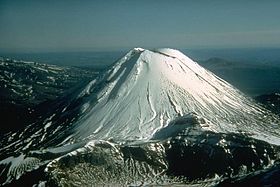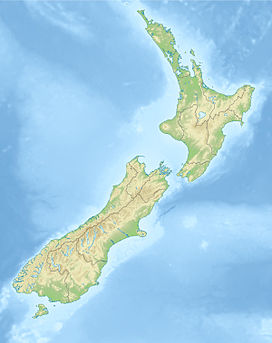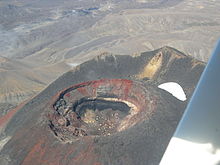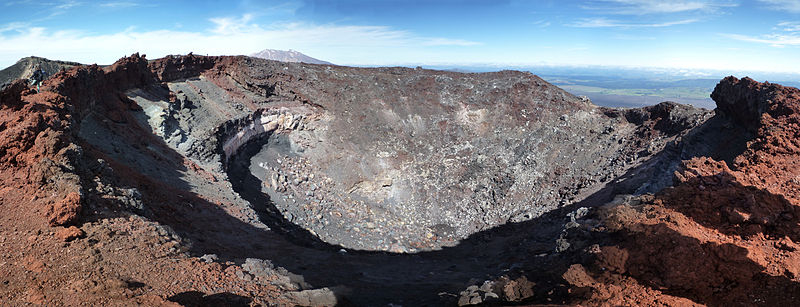- Mount Ngauruhoe
-
Mount Ngauruhoe 
Mount NgauruhoeElevation 2,291 m (7,516 ft) Pronunciation Maori: [ŋaːʉɾʉhɔɛ] Location North Island, New Zealand Coordinates 39°9′24.6″S 175°37′55.8″E / 39.156833°S 175.632167°ECoordinates: 39°9′24.6″S 175°37′55.8″E / 39.156833°S 175.632167°E Geology Type Stratovolcano (active) Volcanic arc/belt Taupo Volcanic Zone Last eruption 1977[1] Climbing First ascent 1839 by John C. Bidwill [2] Easiest route Scramble (summer) Mount Ngauruhoe is an active stratovolcano or composite cone in New Zealand, made from layers of lava and tephra. It is the youngest vent in the Tongariro volcanic complex on the Central Plateau of the North Island, and first erupted about 2,500 years ago. Although seen by most as a volcano in its own right, it is technically a secondary cone of Mount Tongariro.
The volcano lies between the active volcanoes of Mount Tongariro to the north and Mount Ruapehu to the south, to the west of the Rangipo Desert 25 kilometres to the south of the southern shore of Lake Taupo.
Contents
Māori traditions
The volcano was named by Ngātoro-i-rangi, an ancestor of the local Māori iwi, Ngāti Tūwharetoa. Local traditions say that Ngātoro-i-rangi called volcanic fire from his homeland Hawaiki which eventually emerged at Ngauruhoe.[3] The name either commemorates his slave, who had died from the cold before the fire arrived,[3] or refers to the insertions (ngā uru) of his hoe (paddle-like staff) into the ground.
Recent activity
Ngauruhoe erupted 45 times in the 20th century, most recently in 1977.[1] Fumaroles exist inside the inner crater and on the rim of the eastern, outer crater. Climbers who suffer from asthma may be affected by the strong sulphurous gases emitted from the crater.
Ngauruhoe is no longer showing signs of any significant unrest and the Volcanic Alert Level has been reduced to zero (typical background activity).
A significant increase in earthquake activity in May 2006 prompted the alert level to be raised to one (signs of volcano unrest). Over the next two years GeoNet recorded an average of 5 to 30 earthquakes a day close to Ngauruhoe, though the maximum daily number was as high as 80.
Since mid-2008 the number of volcanic earthquakes close to Ngauruhoe has declined to the background level. Regular measurements of volcanic gas levels and the temperature of a summit gas vent have failed to record any significant changes over the last two and a half years. “Since mid-2008 the number of earthquakes has returned to a typical level of a few per week”[4] GNS Science accordingly reduced the alert level for Ngauruhoe to Level 0 on 2 December 2008. “The reduction in earthquake activity means that an eruption in the near future is unlikely without further earthquakes or other changes and the appropriate alert level is therefore zero”, said GNS Science Volcano Section Manager Gill Jolly.
Climbing
The mountain is usually climbed from the eastern side, from the Mangatepopo track. From the Mangateopopo hut to the base of the mountain takes a steady 1 1/2 hour walk; the first 45 minutes are suitable for children or older people. The track then climbs very steeply to the base of the climb. In summer the climb is difficult due to the loose tephra that gives way underfoot. In the summer of 2010 a climber was seriously injured by falling rock. In winter, snow consolidates the tephra. As the slope is about 45 degrees, kicking steps is essential, and this requires fitness. After rain, the snow may be covered by ice which is treacherous. Ice axes, crampons and ropes are recommended in mid winter. Climbers should practice self arrest with ice axes on the lower slopes if icy conditions prevail. Experienced and fit climbers can attempt the climb from the northern side by cutting across the lava flows in the Mangatepopo valley from the Mangatepopo hut.This route is far longer with no flat areas for rest and is not recommended for casual climbers.Climbers on reaching the summit can circum-navigate the crater and descend the normal eastern route.
Film appearance
In the early 2000s Mount Ngauruhoe was used as a stand-in for the fictional Mount Doom in Peter Jackson's The Lord of the Rings movie trilogy, achieving worldwide exposure.[5]
See also
- List of volcanoes in New Zealand
- List of mountains of New Zealand by height
- Volcanism in New Zealand
- Ruapehu
- Tongariro
References
- ^ a b "Tongariro". Global Volcanism Program, Smithsonian Institution. http://www.volcano.si.edu/world/volcano.cfm?vnum=0401-08=.
- ^ "Landcare document". http://www.landcareresearch.co.nz/research/biosystematics/plants/documents/Godley2005ChapmanT_AM.pdf. Retrieved 2007-09-12.
- ^ a b J. Mackintosh Bell (July 1912). "Some New Zealand Volcanoes". The Geographical Journal (Vol. 40, No. 1): 8–10. JSTOR 1778890.
- ^ GNS Alert Bulletin
- ^ Sibley, Brian. The Making of the Movie Trilogy The Lord of the Rings, Houghton Mifflin (2002).
External links
Categories:- Volcanoes of New Zealand
- Stratovolcanoes
- Tongariro Volcanic Centre
- Mountains of New Zealand
- Active volcanoes
Wikimedia Foundation. 2010.





